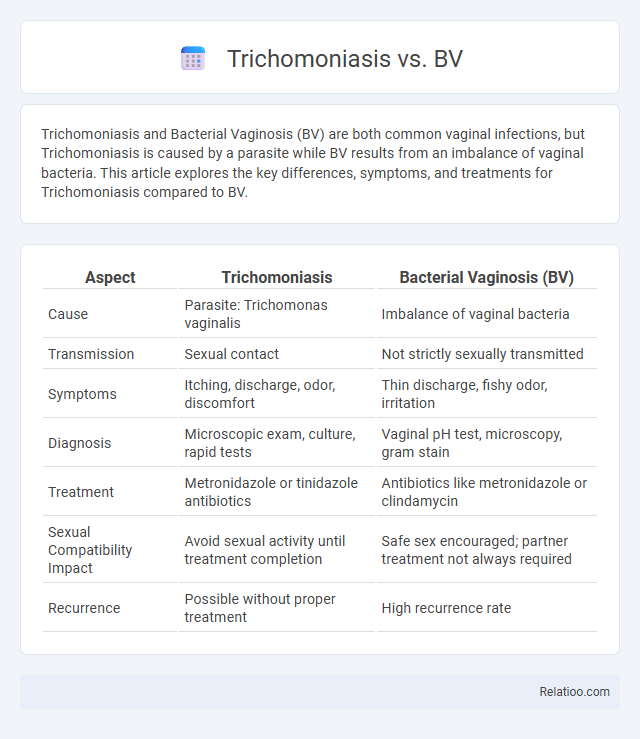Trichomoniasis and Bacterial Vaginosis (BV) are both common vaginal infections, but Trichomoniasis is caused by a parasite while BV results from an imbalance of vaginal bacteria. This article explores the key differences, symptoms, and treatments for Trichomoniasis compared to BV.
Table of Comparison
| Aspect | Trichomoniasis | Bacterial Vaginosis (BV) |
|---|---|---|
| Cause | Parasite: Trichomonas vaginalis | Imbalance of vaginal bacteria |
| Transmission | Sexual contact | Not strictly sexually transmitted |
| Symptoms | Itching, discharge, odor, discomfort | Thin discharge, fishy odor, irritation |
| Diagnosis | Microscopic exam, culture, rapid tests | Vaginal pH test, microscopy, gram stain |
| Treatment | Metronidazole or tinidazole antibiotics | Antibiotics like metronidazole or clindamycin |
| Sexual Compatibility Impact | Avoid sexual activity until treatment completion | Safe sex encouraged; partner treatment not always required |
| Recurrence | Possible without proper treatment | High recurrence rate |
Understanding Trichomoniasis and Bacterial Vaginosis (BV)
Trichomoniasis and Bacterial Vaginosis (BV) are common vaginal infections with distinct causes, symptoms, and treatments; Trichomoniasis is a sexually transmitted infection caused by the parasite Trichomonas vaginalis, while BV results from an imbalance of vaginal bacteria. Both conditions can cause vaginal discharge, odor, and discomfort, but your healthcare provider can differentiate these infections through diagnostic testing like microscopic examination or molecular assays. Early and accurate identification of Trichomoniasis or BV is crucial for effective treatment and preventing potential complications related to reproductive health.
Causes of Trichomoniasis and BV
Trichomoniasis is caused by the protozoan parasite Trichomonas vaginalis, transmitted primarily through sexual contact, while bacterial vaginosis (BV) results from an imbalance of the vaginal microbiota, often an overgrowth of Gardnerella vaginalis and other anaerobic bacteria. Both conditions are associated with sexual activity but differ in etiology: trichomoniasis is an infectious protozoan infection, whereas BV is a dysbiosis of normal vaginal flora. Sexually transmitted infections (STIs) encompass a range of infections including trichomoniasis but exclude non-infectious conditions like BV, which is considered a vaginal microbiome disorder rather than a classic STI.
Key Differences in Symptoms
Trichomoniasis often presents with frothy, yellow-green vaginal discharge accompanied by itching and discomfort during urination, whereas Bacterial Vaginosis (BV) typically causes a thin, grayish-white discharge with a strong fishy odor but usually lacks significant irritation. Sexually transmitted infections (STIs) encompass a broader range of symptoms depending on the pathogen, including painful sores, burning during urination, and unusual discharge, making diagnosis dependent on specific tests. Recognizing these distinct symptom patterns aids clinicians in distinguishing between trichomoniasis, BV, and other STIs for targeted treatment.
Transmission and Risk Factors
Trichomoniasis, Bacterial Vaginosis (BV), and other sexually transmitted infections (STIs) differ notably in transmission and risk factors. Trichomoniasis is primarily transmitted through sexual contact with an infected partner, with increased risk linked to multiple sexual partners and inconsistent condom use. BV is caused by an imbalance in vaginal flora rather than direct sexual transmission, although sexual activity and practices such as douching can increase susceptibility; STIs include a range of infections transmitted mostly via unprotected sex, with risk factors including multiple partners, lack of barrier protection, and prior history of STIs.
Diagnostic Methods for Trichomoniasis vs BV
Accurate diagnosis of Trichomoniasis typically involves microscopic examination of vaginal swabs, culture tests, or nucleic acid amplification tests (NAATs), which offer high sensitivity and specificity. For Bacterial Vaginosis (BV), diagnostic methods include Amsel's criteria--assessing vaginal discharge, pH, clue cells, and whiff test--or Gram stain with Nugent scoring for bacterial flora evaluation. Your healthcare provider may select the diagnostic approach based on clinical presentation and test availability to distinguish between Trichomoniasis and BV effectively.
Treatment Options for Both Infections
Trichomoniasis is effectively treated with oral metronidazole or tinidazole, typically requiring a single dose or a longer regimen for resistant cases. Bacterial vaginosis (BV) treatment primarily involves antibiotics such as metronidazole or clindamycin, available in oral or topical forms to restore normal vaginal flora. Both infections require partner treatment and safe sexual practices to prevent recurrence and transmission, distinguishing them from other sexually transmitted infections that may necessitate different antimicrobial therapies.
Complications and Health Risks
Trichomoniasis can lead to pregnancy complications such as preterm delivery and low birth weight, along with increased susceptibility to HIV infection. Bacterial Vaginosis (BV) raises the risk of pelvic inflammatory disease (PID), which may cause infertility and ectopic pregnancy, while also enhancing vulnerability to sexually transmitted infections (STIs). Both trichomoniasis and BV, as common causes of vaginal infections, contribute to adverse reproductive health outcomes and amplify the risk of acquiring or transmitting STIs.
Prevention Strategies
Preventing Trichomoniasis and Bacterial Vaginosis (BV), two common sexually transmitted infections, involves consistent use of barrier methods like condoms during sexual activity to reduce exposure to infectious agents. Maintaining good vaginal hygiene and avoiding douching helps preserve the natural microbiota, lowering the risk of BV and other infections. You can further protect your sexual health by limiting the number of sexual partners and seeking regular screenings to detect and treat infections early.
Impact on Sexual and Reproductive Health
Trichomoniasis and bacterial vaginosis (BV) are common sexually transmitted infections (STIs) that significantly impact sexual and reproductive health by causing symptoms like vaginal discharge, itching, and discomfort during intercourse. Untreated trichomoniasis or BV can increase Your risk of acquiring other STIs, including HIV, and contribute to complications such as pelvic inflammatory disease (PID), infertility, and adverse pregnancy outcomes like preterm delivery. Early diagnosis and treatment are essential to protect Your reproductive system and maintain overall sexual health.
When to Seek Medical Attention
Seek medical attention immediately if experiencing unusual vaginal discharge, itching, or a strong odor, as these symptoms could indicate Trichomoniasis, Bacterial Vaginosis (BV), or other sexually transmitted infections (STIs). Early diagnosis through laboratory testing, including pelvic exams and swabs, is crucial to prevent complications and effective treatment. Persistent or worsening symptoms despite over-the-counter remedies require prompt consultation with a healthcare provider to rule out or manage these infections efficiently.

Infographic: Trichomoniasis vs BV
 relatioo.com
relatioo.com